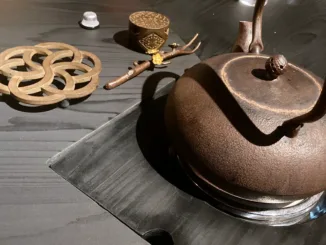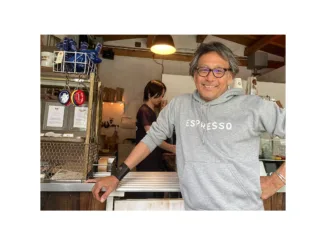
We make a visit to æ, Tokyo’s groundbreaking zero-waste specialty café, for some tips on running a shop sustainably.
BY TANYA NANETTI
SENIOR ONLINE CORRESPONDENT
Among the specialty-coffee shops we planned to visit while in Tokyo, æ had a special place. A coffee friend had recommended it as one of the first zero-waste specialty cafés in Asia. I was curious about its history, and I wanted to understand how it operates on a day-to-day basis, to find some valuable tips that could help my next job behind the bar be more sustainable.

The Brains Behind æ
On a stormy spring afternoon, we reached æ for coffee and a chat with Yuta Namekawa (æ’s barista and bartender) and Tomomi Shinkai (PR of the SG Group, which includes æ and seven other businesses scattered throughout Asia).
Tomomi began by briefly introducing SG Group and its founder, Shingo Gokan, whose 20-plus years of bartending experience took him from Japan to the United States, London, and Shanghai. In Shanghai, he decided to open his first bar, Speak Low, in 2014. Since then, Shingo has been steadily launching new concept bars and now has eight venues worldwide.
It was the chance meeting between Shingo Gokan and barista champion Taka Ishitani during the COVID-19 pandemic that led to the creation of æ.
“At the time,” Tomomi recalls, “Shingo and his group focused on domestic events, as overseas activities were limited. Coordinated by SG Group, the coffee shop and coffee sector collaborated to organize a special event, the SG Coffee Summit, to mark International Coffee Day 2021. At this event Shingo and Tanaka met for the first time. … They discovered that they were both attracted to the zero-waste concept and decided to start a coffee shop together. The cafeteria was opened on May 30, 2022. In Japanese, ’5’ is pronounced ’go,’ ’3’ is pronounced ’mi,’ and ’garbage’ is pronounced ’gomi,’ so we opened on May 30 (530) = Garbage Zero Day!”
æ’s logo is designed to look like both a coffee bean and an infinity sign. In Old English Latin, ”æ” was pronounced ”ash.” It was chosen because it perfectly represents the zero-waste concept of coffee (i.e., to waste nothing, figuratively speaking, ”not even ash”).
Next, Yuta explained what exactly goes on in æ, listing some key points of their zero-waste concept.

No Disposables Here
When we first introduced ourselves to Yuta and Tomomi, it was already clear that things are different in æ. Here there is no room for traditional business cards; All employee information is digitized. In fact, the entire store is paper-free. The menu is available exclusively online, and paper napkins are replaced with cloth. There are no paper cups for takeaway drinks, either. You can bring your own glass, or purchase one from æ—otherwise, no to-go coffee.
“We don’t use paper cups and paper in general to avoid waste,” Yuta says. Coffee is also selected by local specialty roasters (at the time, Leaves Coffee Roasters and Obscura Coffee Roasters) that deliver in large batches to avoid unnecessary packaging waste.

Uniforms, Merch, and Other Zero-Waste Ideas
As we sipped our coffee, Yuta and Tomomi showed us around, pointing out some of the clever ideas æ pursues day after day to ensure its sustainability.
“Our uniforms are made of Japanese paper, which is dyed with spare coffee to give it a nice color,” Tomomi says. “Japanese paper, which is environmentally friendly and biodegradable, can be returned to the ground when it is no longer used.”
Talking about the interior of the café, Tomomi explained that “once we created the space, we wondered if we could use denim scraps from clothing manufacturers and decided to use these scraps for the æ wall.”
Their merch includes shirts (similar to the staff uniform) and reusable Husk Cups made from the skins of coffee cherries that would normally be discarded.
Another novel idea: changing the fate of broken cups. “We try to send broken plates and cups to a dishware manufacturer that reuses them,” Yuta says.
This simple gesture, if widely adopted, could drastically reduce the waste associated with broken china.

Tackling Food, Milk, and Coffee Waste
Next, Yuta explained how they deal with most of the waste from coffee, milk, and food in general.
“We send coffee grounds—our used coffee pucks—to farmers to use as fertilizer, while spare shots of espresso are kneaded into the dough to make bread,” Yuta says.
As we learn while sipping a delicious iced cappuccino, leftover milk (both dairy and oat) is stored and turned into ice cubes. These will be mixed with kokuto (a local cane sugar grown sustainably in Okinawa) to make vegan and dairy iced cappuccinos. The issue of food waste is a bit more complicated. Aside from raising awareness, there is not much that can be done with customer leftovers; recycling organic waste is not a common practice in Japan, and there are no specific bins for it. However, there is much that can be done to prevent food waste in food production.
“If we are not aware of it, waste is generated,” Yuta explains. “So I think we can reduce waste by constantly thinking and working on opportunities. For example, in cocktails, we can avoid them by using techniques that transfer the flavor to the liquid without using the peel or the product itself. For example, in our sister bar, The SG Club, olives are infused into gin for use in their cocktails. Once the flavor has been transferred to the gin, the olives inside are no longer needed and are discarded. We have these olives crushed with lemon zest, which is also no longer needed, and re-formed into cubes that we use in making cocktails from æ.”
Yuta showed us another example of how to avoid food waste with æ’s signature dessert, coffee cherry canelé. The canelé, like many desserts made at æ, is made with egg yolks “saved” from other SG bars where egg whites are commonly used to make cocktails such as classic sours.

Striving for Circular Economy
All this talk about what happens to food and coffee waste brings to mind an important concept in sustainability: the circular economy. It’s defined by the European Parliament as a model that involves “sharing, leasing, reusing, repairing, refurbishing and recycling existing materials and products for as long as possible,” extending the lifecycle of products and minimizing waste, just as it does at æ.
As already seen, dried used coffee pucks are sent to a farm that uses them to grow vegetables, which once grown are sent back to the cafeteria and the other SG group businesses. Leftover food is shared among SG locations to be reused, reduce waste, and optimize costs.
Speaking of recycling and waste, there is no garbage bin in the store (other than a very small one for customer leftovers). Packaging is recycled properly; once it is dried and separated, a recycling company will take care of it. æ is planning to start composting in the near future, which is currently an uncommon practice in the Tokyo metropolitan area.

Sharing (with Customers) Is Caring
How have customers reacted to this new form of commercial exercise?
Yuta explained that about 80% of customers are unfamiliar with the concept of ’zero waste.’ Part of the barista’s routine is to explain it to create awareness, sharing instead of imposing.
”The most difficult thing is to share the concept with the consumer in the right way. If we only focus on that aspect when we think about zero waste, we will impose that idea on our customers. So,” Yuta adds, ”I think it’s important to keep creating delicious coffee and coffee cocktails for our customers, using them as a tool to better communicate our concept.”
And a sip of Yuta’s delicious Espresso Martini—as I finished listening to his explanation—definitely confirmed that æ and the team are on the right track to do so.
ABOUT THE AUTHOR
Tanya Nanetti (she/her) is a specialty-coffee barista, a traveler, and a dreamer. When she’s not behind the coffee machine (or visiting some hidden corner of the world), she’s busy writing for Coffee Insurrection, a website about specialty coffee that she’s creating along with her boyfriend.
Subscribe and More!
Out now: It’s the August + September 2024 issue of Barista Magazine! Read it for free with our digital edition. And for more than three years’ worth of issues, visit our digital edition archives here.
You can order a hard copy of the magazine through our online store here, or start a subscription for one year or two.






